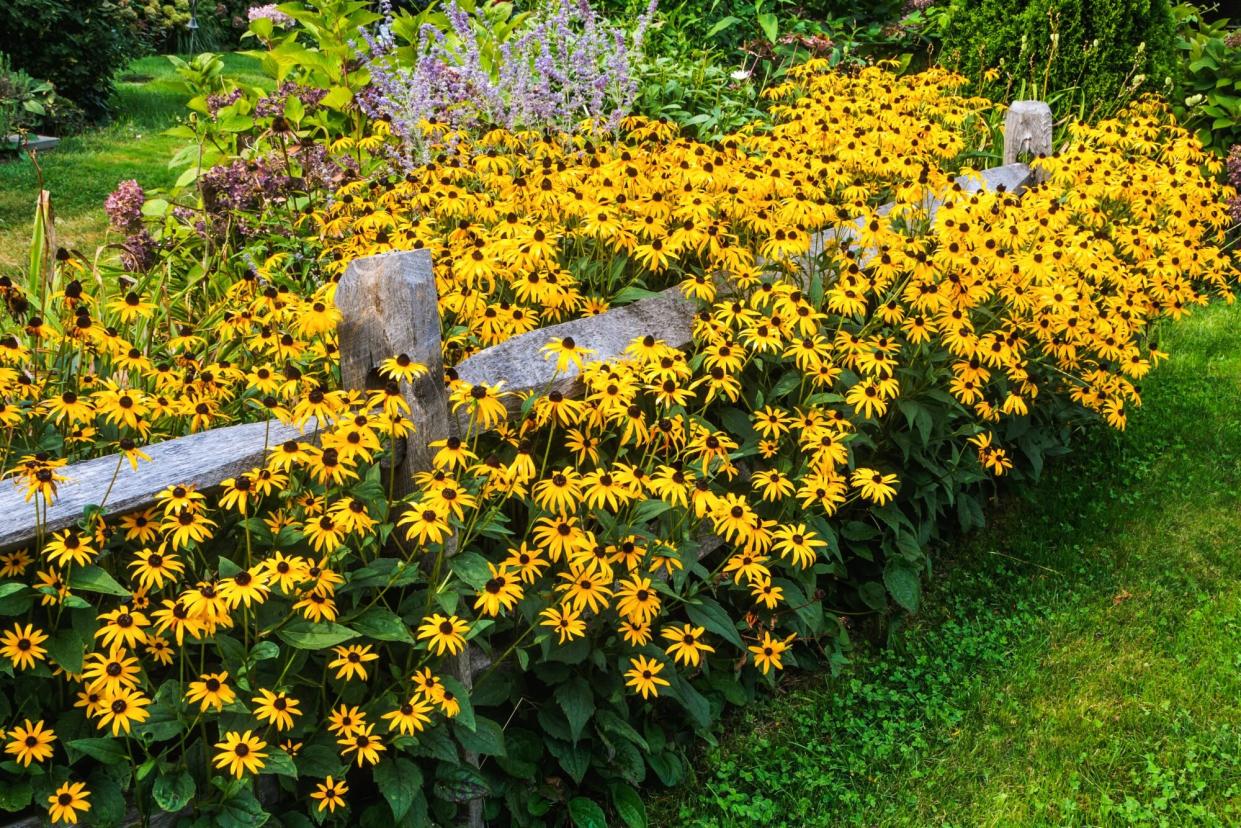How to Grow and Care for Black-Eyed Susans, Vibrant Self-Seeders That You Can Plant in the Fall

GETTY IMAGES
TABLE OF CONTENTS
On This Page
Varieties
Perennials vs. Annuals
How to Plant
Grow and Care Tips
Pest Control
Black-eyed Susans, also known as rudbeckias, Gloriosa daisies, and coneflowers, are a popular variety of flower thanks to their hardy nature. Depending on where you live, they can be grown as annuals, perennials, and even bi-annuals.
The flowers come in a range of shades, but there's one color combination they're best known for: cheerful yellow flowers with a dark black center. Here's what you need to know about adding some of these drought-tolerant wildflowers to your garden.
Identifying Black-Eyed Susans
These plants get their name from that black "eye" in the middle of the flower. "The classic Black-eyed Susan has bright yellow-orange petals with a dark, nearly black center," says Breanna Sherlock, the in-house plant expert for Planta. "There are over 24 native species of this plant throughout North America, so you can also find a variety of colors from canary yellow and sunset orange to deep ruby red."
There are also a number of varieties with striped petals in a mix of shades—as well as double-petal iterations for those who like the look of a fluffier flower, notes Sherlock.
Growing Black-Eyed Susans as Perennials vs. Annuals
Most Black-eyed Susan varieties are flowering perennials hardy to zones 4 through 9, explains Angie Eckert, the vice president of retail operations for Eckert's Farms. "The native species are often found in prairies across the United States," she says. Because of their popularity, many cultivars are currently being propagated for better garden performance. "For example, some varieties have a more compact growth habit, larger flowers, and long bloom times," says Eckert.
According to Sherlock, whether your plants come back year after year depends on your location and the type of species you're growing—so be mindful of your variety's scientific name. "R. fulgida are very reliable perennials because of their rhizomatous root systems, whereas R. hirta are more often grown as annuals (or short-lived perennials) since they are sensitive to cold, wet winters," Sherlock says.
How to Plant Black-Eyed Susans
If you already have a patch of Black-eyed Susans in your garden, you're in luck—these plants are prolific self-seeders, says Patrick McDonough Jr., the senior product and procurement manager at Burpee Gardening. That means that you may get some fresh blooms come spring even if the mother plant doesn't survive the winter.
When to Plant
Starting from scratch is just as simple. "Rudbeckia can be planted from seed indoors, sown directly outdoors, or bought in a pot depending on preference," McDonough says.
If you decide against purchasing and planting mature plants in the spring, scoop up some seeds and start them indoors roughly two months before your locale's last frost date. Or, you can put the seeds directly into the ground when warmer weather hits in the spring or summer. Seeds for perennial varieties, specifically, can be sowed directly outdoors in spring or fall; mature perennials can be transplanted at both points of the year, as well.
Where to Plant
As you get ready to plant this variety, remember that they are enthusiastic re-seeders. Because of this, your flower plot will likely spread considerably over time, so be sure to add them to a spot where they'll have plenty of room to stretch their petals. "Some have a more compact growth habit, so they form round, bushy clumps, while others will grow much taller—some reach up to 4 feet," says Sherlock. "It's always a good idea to keep this in mind when you're designing your garden space."
Black-Eyed Susan Growing and Care Tips
Once your rudbeckias are established, general care and maintenance is a breeze. Heed the following requirements, and these hands-off plants will thrive.
Light: Full sun
Soil: Rich, moist, well-draining soil
Water: Water regularly until plants are established; mature plants are drought-tolerant and require little hydration
Fertilizer: Apply a small amount of all-purpose fertilizer to establish new plants (though, this is not necessary)
Propagation: Harvest seeds from thriving rudbeckias or divide a healthy plant in late fall or early spring
How to Deadhead and Prune Black-Eyed Susans
One of the things Eckert loves most about these plants is that they sustain the local pollinators. "The flowers attract butterflies and the dried seed heads are enjoyed by native birds," she says.
Because of this, you may want to hold off on cutting Black-eyed Susans back. "They can be deadheaded any time of year to promote new flower growth, but pruning the entire plant should be done autumn to early spring," McDonough says. "I advise waiting until spring for a few reasons: the dead foliage insulates the roots to help protect them over the winter and the dried seed heads can feed birds."
Once the plant has died back completely, cut it all the way down. "If you prefer, this can be done in fall—otherwise you can leave them until early spring," Sherlock says, echoing McDonough's sentiments about the plant's importance to local wildlife.
How to Protect Black-Eyed Susans From Pests
If you have Black-eyed Susans in your garden, look out for common pests like aphids and spider mites, which will mainly affect the appearance of the foliage, says McDonough. "Aphids can be mitigated by natural predators, like lady bugs, and spider mites can be controlled by spraying water every other day, he says. "You can also apply an insecticidal soap if you're dealing with an isolated plant or two."

